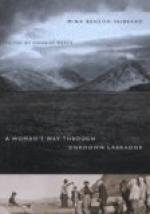Looking up quickly to see what was the trouble I saw him gazing regretfully at a salt shaker which he had just drawn from his pocket.
“Just see,” he exclaimed, “what I’ve been carrying round in my pocket all the time you were running after those caribou, and never thought about it at all. Well, I am sorry for that. I could just have given you a bit and you would have been all right.”
For fifty miles of our journey beyond this point we saw companies of the caribou every day, and sometimes many times a day, though we did not again see them in such numbers. The country was a network of their trails, in the woodlands and bogs cut deep into the soft soil, on the barren hillsides broad, dark bands converging to the crossing place at the river.
At the time I made my journey the general movement of the caribou was towards the east; but where they had come from or whither they were going we could not tell. Piles of white hair which we found later at a deserted camp on Cabot Lake where the Indians had dressed the skins, and the band of white hair clinging to the west bank of the George River, opposite our camp of August 15th, four feet above the then water-level, pointed to an earlier occupation of the country, while the deep cut trails and long piles of whitened antlers, found at intervals along the upper George River, all indicated that this country is favourite ground with them. Yet whether they had been continuously in this territory since the spring months or not I did not ascertain. The Indians whom we found at Resolution Lake knew nothing of their presence so near them.
Towards the end of August the following year Mr. Cabot, while on a trip inland from Davis Inlet, on the east coast, found the caribou in numbers along the Height of Land, and when he joined the Indians there, though the great herd had passed, they had killed near a thousand. It would therefore seem not improbable that at the time I made my journey they were bending their steps in the direction of the highlands between the Atlantic and the George.
The movements of the barren ground caribou of Labrador have never been observed in the interior as they have been in the country west of Hudson Bay. So far as I can learn I alone, save the Indians, have witnessed the great migration there; but from such information as I was able to gather later at the coast, their movements appear to be as erratic as those of the caribou of northern Canada. [See Warburton Pike’s “Barren Grounds of Northern Canada".]
From Mr. John Ford, the Agent of the Hudson’s Bay Company’s Post at the mouth of the George River, I learned that they cross in the neighbourbood of the post at different times of the year. He has seen them there in July and August, in October and November, in January, February, and March. They are seen only a few days in the summer time, but in winter stay much longer—sometimes two months. In 1903 they were near the post all through February and March. On one occasion in the summer one of Mr. Ford’s Eskimo hunters went to look for caribou, and after walking nearly all day turned home, arriving shortly before midnight, but without having found a trace of deer. The next morning at three o’clock they were running about on the hills at the post in such numbers that without trouble as many could be killed as were desired.




